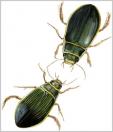Dytiscus water beetle - Dytiscus marginalis
A medium sized beetle (up to 4 cm long) and a member of the most important family of water beetles, the Dytiscidae.
Ditiscus is well adapted for swimming with its streamlined, hydrodynamic body and hind legs provided with strong swimming hairs which act as oars. It can be distinguished from the other large aquatic beetles by the yellow margins of its pronotum and elytra.
Certain morphological characteristics allow the sexes in the adults to be told apart: the males, usually brilliant black and green on top, have smooth elytra and a typical swelling, provided with suckers on the tarsus of the first pair of legs which they use to clasp the female during mating in autmn; the female on the other hand has furrowed elytra to help the male's grip and is more opaque.
Ferocious predators, Dytiscus feeds on small fish, tadpoles and other invertebrates; they can stay under water for quite long periods thanks to the air supply they keep tucked under their elytra and which they renew at regular intervals at the water surface through the tip of their abdomen.
Eggs are laid inside underwater plants. The larvae, up to 60mm long, are the most dangerous invertebrates there are in the fresh water habitat. They are surface breathers and use two short abdominal cerci.
Good swimmers, they nevertheless stay immobile among the underwater vegetation waiting for their prey, which they digest externally by injecting dissolving enzymes through their strong jaws, modified into hollow pincers, then sucking up the juices.
Very common in still water habitats.




